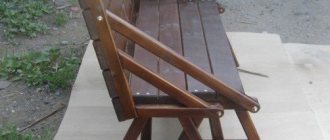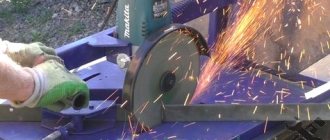Advantages
LEDs have been used in electronics for a long time, but advances in technology have made them brighter than ever before. Therefore, it is not surprising that they have turned into real light sources. Powerful and reliable hand-held flashlights are now increasingly being assembled from LEDs. Such devices can emit bright light over a long distance. In addition, their price on the market is constantly decreasing. LED homemade lights have the following advantages:
- efficiency (devices consume approximately 10 times less electricity than incandescent lamps of similar power);
- durability (LED operating life is at least 10 thousand hours);
- high-quality luminous flux (they emit light similar to natural);
- reliability (practically do not deteriorate due to mechanical shocks and strong vibrations);
- no need for constant maintenance.
Thanks to these advantages, craftsmen recommend making lanterns from LEDs.
Homemade device powered by a AA battery: necessary materials
Making a powerful flashlight with your own hands is a difficult task, for which you first need to prepare all the necessary components. The list includes the following details:
- super bright LED;
- ferrite filter, the diameter (Ø) of which should be 10–15 mm;
- enamel wire Ø 0.1 and 0.25 mm;
- resistor;
- bipolar transistor npn structure (for example, KT315 or BC547C);
- AA battery.
The last element should be present in every home, so there should be no problems finding it, but the remaining components will have to be purchased. In addition, you will need a housing (for example, from an old unnecessary flashlight) or any base on which the parts will be attached.
Figured
To make the next type of lantern, you will only need plain paper of different shades, ribbon or thread to match, a needle or hole punch (depending on what you have available).
Instructions on how to make a New Year's lantern out of paper with your own hands:
- Fold a rectangular sheet into an accordion, pressing each layer thoroughly. Lay out the finished accordion.
- Using a hole punch or needle, make a hole in the middle on each edge at an even distance from the edges.
- Bend a sheet of paper in the middle along the width, then straighten it and do the same only in the other direction.
- Insert thread into the finished holes at the top and bottom. Pull it a little, so the product will narrow at the edges. Cut the bottom thread and fold the top thread into a loop. All!
The best way to use these flashlights is to put a string of lights hanging around the house on each LED. This will make the lighting softer and the product more original.
Assembly diagram
Before making a lantern, you need to make a transformer from a ferrite filter and enamel wire. The method for implementing this device includes the following steps:
- Wind 45 turns of enamel wire with a diameter of 0.25 mm onto the ferrite filter. The result is a secondary winding, to which you will later need to connect an LED.
- Make the primary winding in this way: wind an enameled wire with a diameter of 0.1 mm 30 times, and then direct it to the base of the transistor.
When the described work on making a homemade transformer is completed, then you need to start selecting a resistor. The resistance of the specified element used in the circuit should be about 2 kOhm, since only in this case will the device operate without failures. However, you first need to test the circuit, and to do this you need to replace the resistor with a similar one, but with an adjustable resistance. After connecting the flashlight to a new battery, you need to adjust the resistance on the variable resistor so that the LED passes a current of 25 mA. The next step is to measure the obtained value and install an element with the required rating.
An electrical circuit is needed to power the LED from a battery, since the operating voltage of super-bright diodes is at least 2.5 V. But in the end, you will be able to make a powerful flashlight that will work for quite a long time. The circuit below is a regular blocking generator, so the likelihood of making an error is minimized.
Multilayer
If a simple model does not suit you, you can make it in a more complex variation. It has a non-trivial shape and requires great care in manufacturing. To work, you will need the following materials and tools: a beautiful stand made of strong and dense wire, cardboard of various shades, double-sided tape and stationery scissors. Instead of cardboard, you can take wallpaper that was left after the renovation.
Manufacturing instructions:
- Cut out up to 15 semicircles with a diameter of 10 cm. It is very important to make them identical in size and cut evenly. Please note that the more templates you cut and glue together, the fluffier the final product will be.
- Next, bend each circle in half inward with the printed side.
- Connect the round blanks into a single product.
- Next, glue the core of the lantern and connect the last two sides to fix the structure. To hang the finished decoration, use a thick needle to make holes in the top and thread a loop through it.
Possible problems
If the circuit was drawn up in accordance with the specified requirements, the flashlight should work normally. However, everything does not always work out so well, so you will have to look for the reasons for the malfunction of the device. The experts have identified several common mistakes:
- Small number of turns (less than 15). In this case, no current will be generated in the transformer.
- The ends of the winding were connected without taking into account the condition of multidirectional currents. To solve this problem, you need to wind the wires in different directions.
Craftsmen recommend making an LED flashlight according to the diagram below.
The LED element must be installed instead of an incandescent lamp; it should protrude at least 1 mm from the housing.
Wick
While the main structure is drying, work on the wick for the flashlight.
- Take a piece of cotton fabric and tie several tight knots on it, leaving ends 2-3 cm long on both sides.
- Cut 2 pieces of wire approximately 60 cm long each. Fold them crosswise, strictly perpendicular to each other. Place the knotted fabric in the center of the cross.
- Wrap and tighten each end of the wire around the fabric to prevent the knot from falling out. Then direct the free ends of the wire in opposite directions - with them you will secure the structure to the rim of the dome.
- Melt 1 or 2 candles, completely immerse the knot tied to the wire in liquid wax and leave for 3-5 minutes to saturate the fabric as much as possible.
- After the specified time, remove the fabric and wire from the dish and allow the wax to harden, then wrap the knot in foil, leaving only the edges of the fabric outside.
- Cover all 4 ends of the wire completely with foil.
Homemade 12 V LED flashlight: necessary materials and tools
It should be said right away: the result will be a dimensional device that will more likely look like a small spotlight. However, the product can still be carried with you, for example, to find your way home at night. The design of a lantern of this type is quite simple, since its manufacture requires few parts, or rather:
- LED lamp 12 V;
- two-inch (50 mm) polymer pipe;
- two threaded fittings and a plug for PVC;
- glue for plastic;
- toggle switch;
- electrical tape, nylon ties and heat-shrink tubing - materials necessary for installing electrical wiring;
- 12 V battery.
The last element can be made independently from 8–12 pieces of batteries used in radio-controlled cars. They need to be combined into one battery, the voltage of which will be 12 V. The tools you need to prepare are a hacksaw, a file, sandpaper, wire cutters and a soldering iron with solder.
Making a 12-volt flashlight: step-by-step instructions
The initial stage is the assembly of an electrical circuit, which will consist of an LED lamp, a battery and a toggle switch. Preparatory work must be performed in the following order:
- Solder two wires to the contacts on the LED light bulb. The main thing is that the length of the segments is several centimeters greater than the same size of the battery.
- Insulate all connections.
- Equip the ends of the wires that are connected to the lamp and battery with special connectors for quick connection.
- Install the toggle switch so that it is located on the opposite side of the LED element.
After assembly, it is necessary to check the operation of the electrical circuit. If everything works properly, i.e. the lamp is turned on using the toggle switch, then you can start making the housing. To assemble a powerful flashlight with your own hands from the materials mentioned, you need to follow these instructions:
- Make a hole in one fitting for the lamp.
- Sand the edges with a file and sandpaper.
- Lubricate the edges of the prepared hole with glue, as this will protect the device from moisture.
- Measure the total length of the LED element and the 12-volt battery.
- Cut a piece of the required size from the polymer pipe. The result will be a blank for the body.
- Place all electronics, except the toggle switch, inside the cut pipe. However, the battery must be secured with glue so that it does not damage other elements of the device.
- Glue a threaded fitting to each end of the pipe. The part without a hole must be closed with a plug. The main thing is that you end up with tight connections.
- Install a toggle switch on the entire fitting, which must be fixed on the opposite side relative to the lamp.
- Glue the switch so that it does not protrude outward.
- Screw the plug onto the fitting.
The disadvantage of the device is that to switch the toggle switch you will have to unscrew the plug each time, and then install it again in its original place. This is inconvenient, but thanks to this solution it will be possible to make a sealed case.
Making a lantern consists of a step-by-step level
First of all, take the battery capacity from the unnecessary computer motherboard and disconnect all the connections from the microcircuit. Then the button for regulating the light flux is soldered to the positive contact of the container using copper wires.
- After this, the LED leg is soldered to the second contact of the switch, and the second leg is connected to the negative of the capacitance.
- Get an electrical device that is activated by pressing a button.
- Next, make sure that the device is working properly by inserting the batteries into the container and pressing the button.
- If everything is in order continue working.
- The final stage is to fill the fastening areas with hot glue and wait for the parting to cool.
- Place all the components of the device in the body part and fasten it in the right places for reliability.
- This flashlight is convenient to use and does not take up much space.
“Even a great master cannot train another master: different keys fit different locks.” This famous expression refers to Ilya Grigorievich Erenburg, a Soviet prose writer. And it’s hard to disagree with him.
There are cases when beginners are better at homemade crafts than experienced craftsmen. The reason for this is the innate talent and subtle flair for creating things, a novice master.
How to make a headlamp yourself: instructions
To make the mentioned device you will need:
- LEDs - 3 pcs.;
- battery "Krona" and terminals for it;
- an ordinary plastic bottle cap;
- switch (button);
- elastic strap;
- soldering iron, awl, utility knife and glue.
To make a simple headlamp, you need to follow these steps:
- Use an awl to make three holes in the lid for the LEDs.
- Insert the LED elements sequentially into the resulting slots so that the plus is near the minus.
- Twist the ends of the LEDs in series.
- Solder the wires.
- Use pliers to cut off excess pieces.
- Solder the terminal wires to the free ends of the LEDs.
- Remove one of the terminal wires and secure the switch button into the resulting cut with a soldering iron.
- Solder all parts to the battery.
- Check the circuit for functionality.
- Glue the button to the battery.
- Use a knife to make a small cut in the side of the lid. This must be done in order to neatly lay the wires in it.
- Fill the cover with glue and secure it to the battery.
- Glue the strap to the resulting device.
The result is a miniature, powerful flashlight.
Option #4: Lantern made of paper or cardboard circles
This type of lantern is also perfect for interior decoration and for the Christmas tree. If you make them from thick multi-colored paper, you will get a toy for children. And if you decorate them with various decorative elements or draw something on the finished product, you will get an absolutely unique thing.
1. Cut out 10 identical circles from thin cardboard
2. Fold all the circles in half, right sides inward
3. Glue the circles together in pairs, side to side, until the circle is complete.
4. Before gluing the last two halves together, insert a straightened paper clip into the center of the sphere and secure it with a drop of hot glue. Bend the outer end of the paper clip with a hook - you will use it to hang the flashlight
5. Decorate the lantern with ribbons, tassels or other decorative elements.











